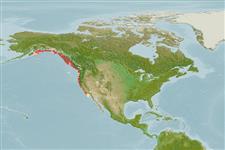Teleostei (teleosts) >
Perciformes/Scorpaenoidei (Scorpionfishes) >
Sebastidae (Rockfishes, rockcods and thornyheads) > Sebastinae
Etymology: Sebastes: Greek, sebastes = august, venerable (Ref. 45335); nebulosus: From the Latin nebulosus, meaning 'clouded' (Ref. 27436).
More on author: Ayres.
Environment: milieu / climate zone / depth range / distribution range
Ecology
Marine; reef-associated; depth range 3 - 128 m (Ref. 2850), usually ? - 92 m (Ref. 27437). Temperate; 4°C - 8°C (Ref. 131068); 60°N - 32°N, 155°W - 117°W
Eastern Pacific: southeast Alaska to Redondo Beach and San Miguel Island, southern California, USA.
Length at first maturity / Size / Weight / Age
Maturity: Lm 27.0, range 26 - ? cm
Max length : 45.0 cm TL male/unsexed; (Ref. 27437); max. published weight: 1.7 kg (Ref. 40637); max. reported age: 79 years (Ref. 39247)
Dorsal spines (total): 13; Dorsal soft rays (total): 13 - 14; Anal spines: 3; Anal soft rays: 6 - 8. Head spines strong - nasal, preocular, postocular, tympanic and parietal spines present, supraocular, coronal and nuchal spines absent (Ref. 27437). Parietal ridges very high and thick (Ref. 27437). Mouth small (Ref. 27437). Caudal fin rounded (Ref. 27437). Body blue or black, mottled with yellow; some individuals white ventrally; a broad yellow stripe from about the 3rd dorsal spine runs into or along the lateral line (Ref. 27437). Pelvic, anal and caudal fins are dark (Ref. 27437).
A territorial species occurring on the open coast, among rocks and reefs (Ref. 2850). Has mildly venomous spines (Ref. 27436). Viviparous (Ref. 34817). One of the tastiest rockfishes (Ref. 2850) but rarely found in markets because it is rarely caught (Ref. 27436).
Life cycle and mating behavior
Maturity | Reproduction | Spawning | Eggs | Fecundity | Larvae
Eschmeyer, W.N., E.S. Herald and H. Hammann, 1983. A field guide to Pacific coast fishes of North America. Boston (MA, USA): Houghton Mifflin Company. xii+336 p. (Ref. 2850)
IUCN Red List Status (Ref. 130435: Version 2024-1)
Human uses
Fisheries: minor commercial; gamefish: yes; aquarium: public aquariums
Tools
Special reports
Download XML
Internet sources
Estimates based on models
Preferred temperature (Ref.
123201): 5.5 - 12.2, mean 8.9 °C (based on 138 cells).
Phylogenetic diversity index (Ref.
82804): PD
50 = 0.5000 [Uniqueness, from 0.5 = low to 2.0 = high].
Bayesian length-weight: a=0.01000 (0.00495 - 0.02022), b=3.09 (2.92 - 3.26), in cm total length, based on LWR estimates for this Genus-body shape (Ref.
93245).
Trophic level (Ref.
69278): 3.9 ±0.3 se; based on diet studies.
Generation time: 5.7 ( na - na) years. Estimated as median ln(3)/K based on 2
growth studies.
Resilience (Ref.
120179): Low, minimum population doubling time 4.5 - 14 years (tm=7; tmax=79).
Prior r = 0.18, 95% CL = 0.12 - 0.26, Based on 3 full stock assessments.
Fishing Vulnerability (Ref.
59153): Moderate to high vulnerability (49 of 100).
Nutrients (Ref.
124155): Calcium = 8.18 [2.81, 24.18] mg/100g; Iron = 0.114 [0.044, 0.276] mg/100g; Protein = 19 [18, 20] %; Omega3 = 0.723 [0.269, 1.990] g/100g; Selenium = 19.9 [7.0, 62.8] μg/100g; VitaminA = 67 [19, 233] μg/100g; Zinc = 0.407 [0.206, 0.767] mg/100g (wet weight);
